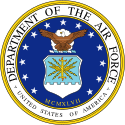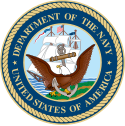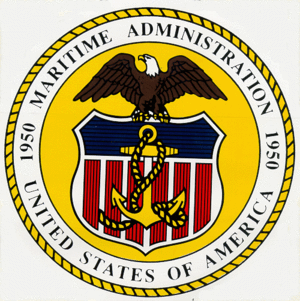United States Merchant Marine
Die United States Merchant Marine (USMS) wurde 1939 im Rahmen der Bestimmungen des 1936 vom US-Kongress beschlossenen Merchant Marine Act als US-Handelsmarine gegründet. Aufgabe dieser Organisation war es, Männer darauf vorzubereiten, als Offiziere und Besatzungsmitglieder in Friedenszeiten auf zivilen Schiffen und in Verteidigungsfall auf Kriegsschiffen der United States Navy ihren Dienst zu tun.
Ziele
Auf Plakaten und Werbepostern wurden Seeleute von der War Shipping Administration angeworben, die die U.S. Merchant Marine bilden sollten. Für Matrosen bzw. Seeleute mit Erfahrung betrug die Ausbildungszeit drei Monate, für sogenannte Neulinge sechs Monate. Die jungen Männer mussten ein Mindestalter von 19 Jahren haben. Man sah ihre Ausbildung als mitentscheidend dafür an, den Krieg gewinnen zu können. Es meldeten sich tausende junge Männer für die neue amerikanische Handelsflotte, die unter den wachsamen Augen des entsprechenden Personals ausgebildet wurden, um dann entsprechend ihren Fähigkeiten eingesetzt werden zu können. Ihr Aufgabenbereich lag vor allem darin, Kriegsmaterial (Bomben, Munition, Waffen, Fahrzeuge, Flugzeuge, Benzin, aber auch Lebensmittel und andere Materialien) auf dem Seeweg an die Truppen zu liefern. So wurde es auch im Merchant Marine Act von 1936 festgeschrieben. Für die Landesverteidigung sei es erforderlich, dass die Vereinigten Staaten eine bestens ausgestattete Handelsmarine mit den besten und geeignetsten Schiffen hätten.[1][2][3]
Die Organisation hatte die Aufgabe, die Entwicklung und Aufrechterhaltung einer angemessenen und ausgewogenen amerikanischen Handelsmarine sicherzustellen, um den Handel der Vereinigten Staaten zu fördern und so zur nationalen Verteidigung beizutragen.[1][2][3]
Diese während des Zweiten Weltkrieges stark ausgelastete Organisation wurde inzwischen weitgehend aufgelöst und/oder in andere Bundesstellen integriert, teilweise waren/sind die Unteroffiziere auch weiterhin als Verwaltungsbeamte und Lehrer in ihrer Funktion, die sie in der U.S. Merchant Marine Academy einnahmen, in anderen maritimen Akademien tätig.[1][2][3]
Oscarnominierung
Die United States Merchant Marine wirkte an dem 1942 erstellten Dokumentarfilm A Ship Is Born mit und wurde für diese Produktion mit einer Nominierung für den Oscar in der Kategorie „Bester Dokumentarfilm“ bedacht. Der Film wurde von Warner Bros. gedreht. Der Oscar ging an folgende vier Dokumentarfilme:
- Schlacht um Midway – U.S. Navy
- Kokoda Front Line! – Australian News and Information Bureau
- Moscow Strikes Back – Artkino Pictures
- Vorspiel zum Krieg – United States Office of War Information
Der Film ist public domain und kann im Internet Archive angeschaut werden.[4]
Siehe auch
- United States Maritime Service
- United States Maritime Commission
Weblinks
- A Ship Is Born in der Internet Movie Database (englisch)
Einzelnachweise
- ↑ a b c World War II U.S. Navy Armed Guardand World War II U.S. Merchant Marine armed-guard.com (englisch). Abgerufen am 19. Februar 2015.
- ↑ a b c The U.S. Merchant Marine armed-guard-com/about (englisch). Abgerufen am 19. Februar 2015.
- ↑ a b c United States Merchant Marine usmm.org (englisch). Abgerufen am 19. Februar 2015.
- ↑ A Ship Is Born – Film
Auf dieser Seite verwendete Medien
U.S. Department of The Army Emblem.
- In the center is a Roman cuirass below a vertical unsheathed sword, point up, the pommel resting on the neck opening of the cuirass and a Phrygian cap supported on the sword point, all between on the right an esponton and on the left a musket with fixed bayonet crossed in saltire behind the cuirass and passing under the sword guard.
- To the right of the cuirass and esponton is a flag of unidentified designs with cords and tassels, on a flagstaff with spearhead, above a cannon barrel, the muzzle end slanting upward behind the cuirass, in front of the drum, with two drumsticks and the fly end of the flag draped over the drumhead; below, but partly in front of the cannon barrel, is a pile of three cannon balls.
- To the left of the cuirass and musket is a national color of the Revolutionary War period, with cords and tassels, on a flagstaff with spearhead, similarly arranged above a mortar on a carriage, the mortar facing inward and in front of the lower portion of the color and obscuring the lower part of it; below the mortar are two bomb shells placed side by side.
- Centered above the Phrygian cap is a rattlesnake holding in its mouth a scroll inscribed "This We'll Defend."
- Centered below the cuirass are the Roman numerals "MDCCLXXVIII."
- For differences between this text description and the emblem shown above, see "Army Seal vs. Army Emblem", below.
Seal of United States Department of the Air Force - military department for the United States Air Force and the United States Space Force
Seal of the United States Marine Corps. It is defined in Executive Order 10538 (alternate source) as:
For more information, see here.Standing upon the western hemisphere of the terrestrial globe containing the lines of latitude and topographical outlines of North, Central, and South America, an American bald eagle with wings displayed horizontally and inverted holding in his beak a scroll inscribed with the motto SEMPER FIDELIS, all bronze. Behind the western hemisphere a foul anchor bend sinister-wise with stock, arms, and flukes in slight perspective, all bronze, on a scarlet background and within a dark blue band edged in gold circumscribed by a gold rope rim and inscribed DEPARTMENT OF THE NAVY • UNITED STATES MARINE CORPS in gold letters. The central device of the seal is the emblem of the United States Marine Corps.
Seal of the United States Department of Homeland Security. A graphically styled American eagle appears in a circular blue field. The eagle's outstretched wings break through an inner red ring into an outer white ring that contains a circular placement of the words "U.S. DEPARTMENT OF" in the top half and "HOMELAND SECURITY" in the bottom half. The outer white ring has a silvery gray border. As in The Great Seal, the eagle’s left claw holds an olive branch with 13 leaves and 13 seeds while the right claw grasps 13 arrows. Centered on the eagle's breast is a shield divided into three sections containing elements that represent the homeland "from sea to shining sea." The top element, a dark blue sky, contains 22 stars representing the original 22 agencies and bureaus that have come together to form the department. The left shield element contains white mountains behind a green plain underneath a light blue sky. The right shield element contains four wave shapes representing the oceans, lakes and waterways alternating light and dark blue separated by white lines.
United States Coast Guard Seal, in correct PMS colors. This emblem shall only be used in accordance with the Coast Guard Heraldry Manual, and is not to be reproduced commercially without prior approval of the U.S. Coast Guard.
*Description: On a circular background of fair sky and moderate sea with land in sinister base, a tri-mast square rigged ship under way before a fair breeze with after top-sail furled, commission pennant atop the foremast, National Ensign atop the main, and the commodore's flag atop the mizzen. In front of the ship a luce-type anchor inclined slightly bendwise with the crown resting on the land and, in front of the shank and in back of the dexter fluke, an American bald eagle rising to sinister regarding to dexter, one foot on the ground, the other resting on the anchor near the shank; all in proper colors. The whole within a blue annulet bearing the inscription "Department of the Navy" at the top and "United States of America" at the bottom, separated on each side by a mullet and within a rim in the form of a rope; inscription, rope, mullet, and edges of annulet all gold. *Background: The policy for use of the Navy seal and emblem is contained in SECNAV Instr 5030.4 and SECNAV Instr 5030.6. The seal design was approved by the President of the United States by Executive Order 10736 dated October 23, 1957. Request for use of the Navy emblem should be submitted in writing to Defense Printing Service, ATTN: DPSMO, 8725 John Kingman Rd Suite 3239, Fort Belvoir, VA 22060-6220. The telephone number is (703) 767-4218. 1879 version here: http://etc.usf.edu/clipart/54900/54985/54985_seal_navy.htm
Seal of the United States Space Force.
Seal of the United States Department of Defense from 2001 to 2022.











